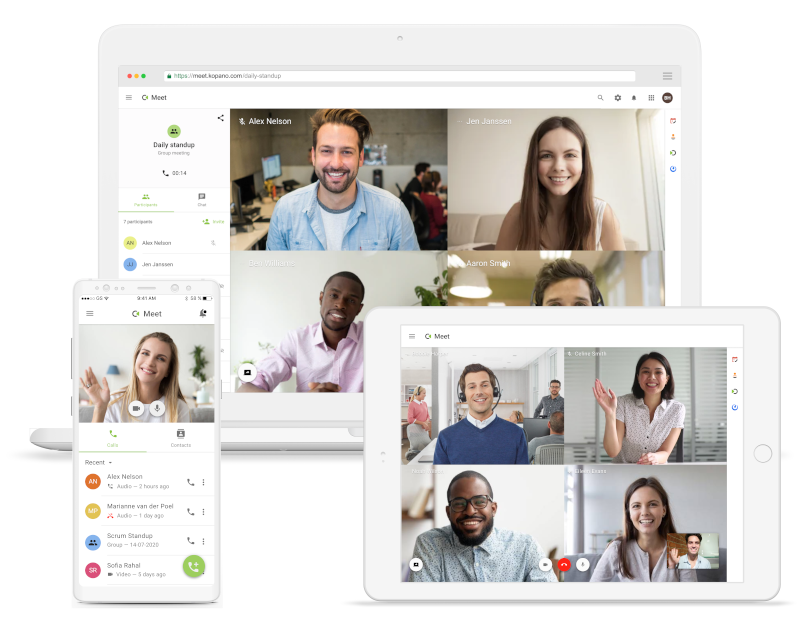There’s a lot going on in the world of videoconferencing. While Microsoft is pushing users of Skype for Business to the cloud-based Microsoft Teams, Google announced the end-of-life of the classic Google Hangouts. It plans to transition all of its users, consumers, and enterprise, to Google Chat and Google Meet before the end of 2020.
This news is interesting because it shows once again how terribly dependent companies are on the whims of big cloud providers. It seems these tech giants can do whatever they want without thinking about how their decision affects their users. Especially for enterprise-level users, it is hard, if not impossible to switch to other providers if they do not agree with the direction their (cloud) provider is taking. And all the directions Google went…
Google, Make Up Your Mind!
In recent years, Google has changed its messaging strategy more often than the Netherlands came second in the FIFA World Cup final. First, there was Google Talk. Then came Wave. Then came Huddle (launched around the same time as Hangouts) Huddle was shut down in favor of Hangouts and Hangouts… Wait, before we go there, let’s not forget Google Allo, the instant messaging app that was supposed to compete with WhatsApp. We all know how that ended.
Google Hangouts and Beyond
Anyway, Hangouts still exists. The question is, how much longer? The classic Hangouts will be replaced by Hangouts Meet and Hangouts Chat. And who knows how long it will take for Google to change its mind again. To make it even more complicated. The Meet and Chat apps are not the only messenger apps from Google. In Google Play you can still download Google Duo for video calls and Google Voice for free calls and texts. Finally, there is the Android Messenger app for SMS and MMS.
Innovation Needs Change
Having all these different tools is not necessarily a bad thing. It shows Google’s hunger for innovation and shows why Google is still one of the most innovative companies in the world. Every year, the company brings dozens of new products to the market (to be fair, they also terminate quite a few of them). Some of these products, including Gmail and Google Maps, are the result of the famous 20% time initiative. Others, like TensorFlow, are products developed in Google’s Incubator And then there are products that are simply listed on Google’s roadmap (e.g. Kubernetes).
To Change Or Not To Change
Nevertheless, these constant changes can be a bit annoying for consumers, let alone enterprises. Because you must consider that every time Google (or any other IT provider for that matter) decides to end the life of one tool in favor of another one, a company has to migrate all its users to the new system. And as most of the admins here know, that’s no piece of cake. The time and money it takes are considerable. Still, often, migrating is the only option they have as these big cloud software providers are really good at making you dependent on their tools.
Enterprise-Ready Software
But hold a second. Are these tools even meant to be used by enterprises? The answer is no, they are not. Hangouts is an enterprise-ready app, as was Google+, but most of Google’s products are developed with consumers in mind. So if you decide to use these consumer products anyway, that’s your choice. They could work fine for you. But please, do bear in mind the consequences. Not only would you have to take into account the fact that you’ll most likely have to switch tools in the near future. Consumer software is also not known to be the most secure or flexible option.
Break free and keep control
So what can you as a company do to get hold of the best tools and at the same time achieve technological independence? Make sure you do not depend on a specific vendor. How? The report written by the German Ministry of Economics provides a model that includes requirements for digital sovereignty. The table included in the report is a good starting point (we’ve translated the table into English for you in this blog).
What more can you do? Besides making sure you fulfill as many all the requirements included in the layer model, ask yourself critical questions like:
- What happens if I want to add a new tool to my stack (in particular if your provider offers a comparable tool)?
- If my provider changes their business model or corporate strategy, am I forced to go with them or can I move my data to another provider?
- What if they go bankrupt?
- If I’m not happy with my current provider, can I switch whenever I like and if I do, what happens to my data?
And last but not least, for every piece of software you use, make sure you know what happens to your data. No idea? Then find out. If you can’t find any answers, then it might time to look into alternative solutions.
What about videoconferencing in particular?
If you want full data control, choose an open-source, WebRTC-based tool like Meet (full disclosure: WebRTC was developed by the Google Hangouts team ?). Meet can be hosted on-premises or in the private cloud. The open-source aspect ensures there are no hidden back-doors in the software or its encryption and that you do not depend on us for the continuation of the product. Furthermore, Meet is end-to-end encrypted which means that third parties cannot access your data.
Because Meet is a WebRTC-based and a progressive web app, you can join calls and share your screen without downloading any apps or plugins. We would, of course, give you the full sales pitch here, but fortunately for you, we have a dedicated web page for that purpose. Interested? On the web page we’ve also included a full-featured demo: try it now!
Switching from Hangouts or Skype to Kopano Meet
Want to know how you can switch from Google Hangouts to Kopano Meet? Let us know and we’ll contact you as soon as we can!



